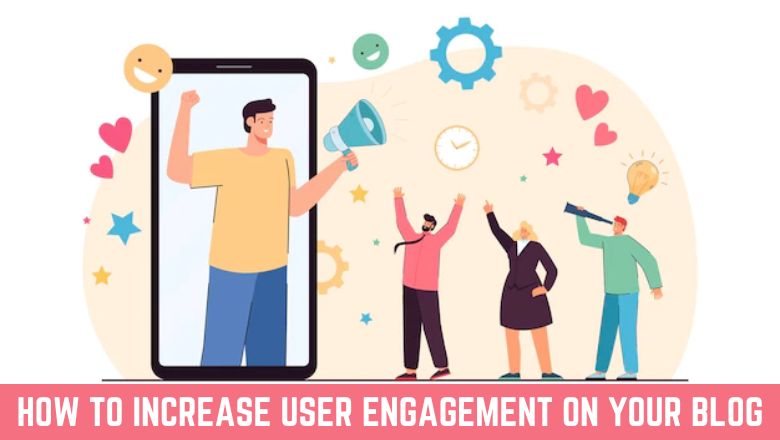The process by which a user engages with your post or content is known as User Engagement on a Blog.
- Importance of User Engagement on your Blog:
- How to Increase User Engagement on Your Blog in 2024?
- Top 7 ways to boost your blog engagement 2024
- Short Paragraphs for High Engagement blogs:
- Internal Linking Structure for SEO:
- User-Friendly Content:
- Keeping Readers Engaged with Other Related Posts:
- Audience Centric Content:
- Collect Email Addresses from Users:
- Using Responsive Design:
- Speed up website Page loading:
- Conclusion:
It is difficult for many bloggers to engage their readers and also worry about how to write an engaging blog post. Nothing to worry about, in this article, I am going to discuss How to Increase User Engagement on Your Blog in 2024.
There are multiple ways to go about it. Possible examples include:
- The comment system on your blog.
- Use social media platforms like Facebook, Twitter, etc. to share your blog content.
In addition to engaging your user in these ways, they will encourage them to return to your blog again and again.
As a beginner, you might want to check out the evergreen fields of blogging and content writing.
Engaged users become regular visitors and loyal followers of your blog.
In order to understand how you can increase user engagement on your blog, let’s first review the importance of user engagement.
Importance of User Engagement on your Blog:
An important factor for search engine ranking is user engagement. Every single activity you perform on your blog is checked by Google.
A user who shares your posts or comments on them contributes a lot to your search engine ranking and therefore engages more and more traffic to your blog.
Getting your targeted audience to engage might be tricky, but you don’t have to worry about it.
My goal here is to bring you some of the most useful and amazing tips and techniques for engaging your audience and keeping your blog interesting and engaging.
How to Increase User Engagement on Your Blog in 2024?
You are a blogger whose visitors are below average or your visitors are not engaging with your content.
Here are some of the amazing tips and techniques that will help you increase user engagement on your blog and make it profitable.
Top 7 ways to boost your blog engagement 2024
Short Paragraphs for High Engagement blogs:
If your paragraphs exceed five lines, no matter how accurate and unique your content is, it will not make sense to your reader. A paragraph should be 1-4 lines long or no more than five lines long in your blog post.
Your content will be more readable and structured if you make short paragraphs. By using short paragraphs, you can easily convey your message to your readers and make your blog more engaging
Internal Linking Structure for SEO:
The importance of internal linking in Search Engine Optimization cannot be overstated. There are several reasons why internal linking is beneficial:
- Your blog’s user engagement will increase with this feature.
- Increased page views result in a lower bounce rate for a single visitor.
- The more information you have about your keyword, the higher your blog post’s ranking will be.
- Your target audience and Google can be trapped by internal links if you use the wrong ones. When you place the wrong interlinks, your ranking might be disturbed.
User-Friendly Content:
My opinion is that this is one of the best tips ever for bloggers. The value of content is well known to all of us.
Creating user-friendly content offers the following benefits:
- Good content is a way to Gain More Traffic.
- Good content can convince your visitors.
- By creating easy, simple, and understandable content, you will increase your blog’s user engagement. Due to the fact that content is one of the first and most important factors
- Blogs are primarily viewed for the things they contain.
Keeping Readers Engaged with Other Related Posts:
You can engage your readers by displaying related posts at the end of your article, just as you would with internal links. You can increase user engagement on your blog by understanding the psychology of your readers.
Your reader will either leave your blog after reading your content or search for related information in a search engine once he/she is finished reading it.
To get your visitors to stay on your blog and read your other articles, display the list of articles that relate to your post.
If you display related posts, your readers will stay longer on your blog, but make sure that you display relevant and related articles otherwise, they might get distracted and might never return.
Audience Centric Content:
Instead of focusing on what excites you, find out what excites your potential customers or readers. Make sure to ask your readers for suggestions, not only will it keep you in contact with them, but it will also make your blog more engaging for your readers.
Collect Email Addresses from Users:
At the end of each post, ask for your readers’ email addresses so you can keep them updated about your blog. Using their email address, you can send them updates about your new blog posts.
You will be able to gain even more traffic to your website and, by gaining more traffic, you will be able to increase user engagement.
Don’t always search for new visitors, make your old visitors your regular visitors
Using Responsive Design:
Try to make your website user-friendly so that your visitors can easily navigate it. Design a responsive website that is suitable for users on both desktops and mobile devices.
61.2% of people are estimated to use smartphones for visiting different websites, according to a survey conducted in 2019.
Bad user experiences on smartphones will prevent users from visiting your website and consequently decrease user engagement if your website doesn’t work well on a smartphone.
Speed up website Page loading:
Since Google’s new “CORE WEB VITAL” Algorithm is fully built for checking the page load speed, page speed really matters to increase user engagement in 2024.
In Google, when a user searches for a query and sees the top 5 results on the first page, they can only click one to five ranked websites. Having a slow-loading top-ranking website will not help users to engage with your blog.
When Users are waiting for page content and the page loads after 20 seconds or 30 seconds, that’s why Google and Users do not give priority to your website’s content.
Your Website page bounce rate will be much higher if your page loads slowly and the user did not engage with your blog. Over time, this will negatively impact your Google SERPs and cause you to be deranked.
The Google Speed Update [0, 1000ms] is considered good, while LCP [0, 2500ms] and CLS [0, 0.1] will have good results. With this free tool, you can check your page’s speed right now.
If you want your website to get more engagement, try to improve website loading speed by about 1-2 seconds.
You need to know about audience engagement strategies if you want to rank your blog posts in Google search results. By having a good traffic source on your blog, you will be able to increase your engagement.
Conclusion:
Based on the above-given explanation, we can conclude that the user experience must be improved more and more for better user engagement.
As you provide better user experiences, you will receive greater engagement from your users.
In 2024, I hope this article on “How to increase user engagement on your blog” will help your blog grow higher and higher. My upcoming articles will discuss blogging trends in more detail.
You can enjoy amazing content regarding Digital Marketing until then by clicking here.
Use the comment section to share your feedback. Keep learning and learning with Rehmat Ullah.

